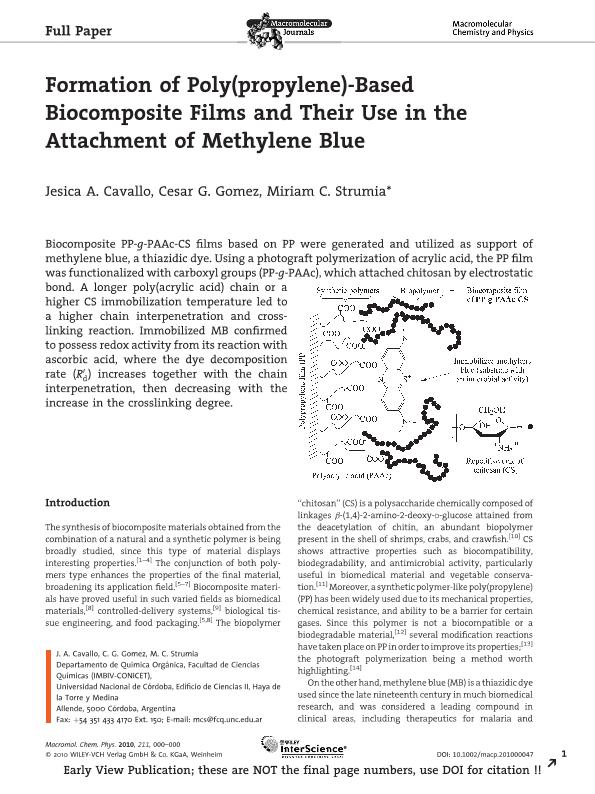Artículo
Formation of poly(propylene)-based biocomposite films and their use in the attachment of methylene blue
Fecha de publicación:
08/2010
Editorial:
Wiley VCH Verlag
Revista:
Macromolecular Chemistry And Physics
ISSN:
1022-1352
e-ISSN:
1521-3935
Idioma:
Inglés
Tipo de recurso:
Artículo publicado
Clasificación temática:
Resumen
Biocomposite PP-g-PAAc-CS films based on PP were generated and utilized as support of methylene blue, a thiazidic dye. Using a photograft polymerization of acrylic acid, the PP film was functionalized with carboxyl groups (PP-g-PAAc), which attached chitosan by electrostatic bond. A longer poly(acrylic acid) chain or a higher CS immobilization temperature led to a higher chain interpenetration and crosslinking reaction. Immobilized MB confirmed to possess redox activity from its reaction with ascorbic acid, where the dye decomposition rate (R0d) increases together with the chain interpenetration, then decreasing with the increase in the crosslinking degree. interpenetration, then decreasing with the increase in the crosslinking degree. bond. A longer poly(acrylic acid) chain or a higher CS immobilization temperature led to a higher chain interpenetration and crosslinking reaction. Immobilized MB confirmed to possess redox activity from its reaction with ascorbic acid, where the dye decomposition rate (R0d) increases together with the chain interpenetration, then decreasing with the increase in the crosslinking degree. interpenetration, then decreasing with the increase in the crosslinking degree. methylene blue, a thiazidic dye. Using a photograft polymerization of acrylic acid, the PP film was functionalized with carboxyl groups (PP-g-PAAc), which attached chitosan by electrostatic bond. A longer poly(acrylic acid) chain or a higher CS immobilization temperature led to a higher chain interpenetration and crosslinking reaction. Immobilized MB confirmed to possess redox activity from its reaction with ascorbic acid, where the dye decomposition rate (R0d) increases together with the chain interpenetration, then decreasing with the increase in the crosslinking degree. interpenetration, then decreasing with the increase in the crosslinking degree. bond. A longer poly(acrylic acid) chain or a higher CS immobilization temperature led to a higher chain interpenetration and crosslinking reaction. Immobilized MB confirmed to possess redox activity from its reaction with ascorbic acid, where the dye decomposition rate (R0d) increases together with the chain interpenetration, then decreasing with the increase in the crosslinking degree. interpenetration, then decreasing with the increase in the crosslinking degree. -g-PAAc-CS films based on PP were generated and utilized as support of methylene blue, a thiazidic dye. Using a photograft polymerization of acrylic acid, the PP film was functionalized with carboxyl groups (PP-g-PAAc), which attached chitosan by electrostatic bond. A longer poly(acrylic acid) chain or a higher CS immobilization temperature led to a higher chain interpenetration and crosslinking reaction. Immobilized MB confirmed to possess redox activity from its reaction with ascorbic acid, where the dye decomposition rate (R0d) increases together with the chain interpenetration, then decreasing with the increase in the crosslinking degree. interpenetration, then decreasing with the increase in the crosslinking degree. bond. A longer poly(acrylic acid) chain or a higher CS immobilization temperature led to a higher chain interpenetration and crosslinking reaction. Immobilized MB confirmed to possess redox activity from its reaction with ascorbic acid, where the dye decomposition rate (R0d) increases together with the chain interpenetration, then decreasing with the increase in the crosslinking degree. interpenetration, then decreasing with the increase in the crosslinking degree. -g-PAAc), which attached chitosan by electrostatic bond. A longer poly(acrylic acid) chain or a higher CS immobilization temperature led to a higher chain interpenetration and crosslinking reaction. Immobilized MB confirmed to possess redox activity from its reaction with ascorbic acid, where the dye decomposition rate (R0d) increases together with the chain interpenetration, then decreasing with the increase in the crosslinking degree. interpenetration, then decreasing with the increase in the crosslinking degree. R0d) increases together with the chain interpenetration, then decreasing with the increase in the crosslinking degree.
Palabras clave:
Polypropylene Based
,
Chitosan
,
Methylene Blue
,
Multilayers
Archivos asociados
Licencia
Identificadores
Colecciones
Articulos(IMBIV)
Articulos de INST.MULTIDISCIPL.DE BIOLOGIA VEGETAL (P)
Articulos de INST.MULTIDISCIPL.DE BIOLOGIA VEGETAL (P)
Citación
Cavallo, Jesica Anabel; Gomez, Cesar Gerardo; Strumia, Miriam Cristina; Formation of poly(propylene)-based biocomposite films and their use in the attachment of methylene blue; Wiley VCH Verlag; Macromolecular Chemistry And Physics; 211; 16; 8-2010; 1793-1802
Compartir
Altmétricas




